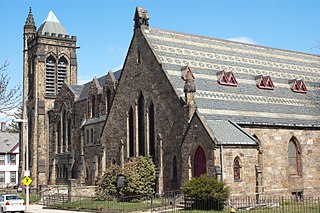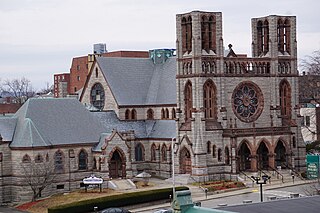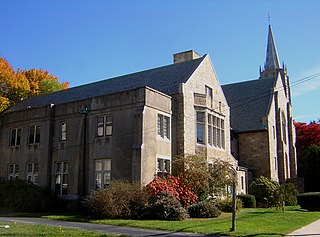
Dracut is a town in Middlesex County, Massachusetts, United States. At the 2020 census, the town's population was 32,617, making it the second most populous town in Massachusetts with an open town meeting system of governance. The town covers a total area of 21.36 square miles, 0.5 square miles of which are water.
The history of Lowell, Massachusetts, is closely tied to its location along the Pawtucket Falls of the Merrimack River, from being an important fishing ground for the Pennacook tribe to providing water power for the factories that formed the basis of the city's economy for a century. The city of Lowell was started in the 1820s as a money-making venture and social project referred to as "The Lowell Experiment", and quickly became the United States' largest textile center. However, within approximately a century, the decline and collapse of that industry in New England placed the city into a deep recession. Lowell's "rebirth", partially tied to Lowell National Historical Park, has made it a model for other former industrial towns, although the city continues to struggle with deindustrialization and suburbanization.
Barzillai Lew was an African-American soldier who served with distinction during the American Revolutionary War.

St. Patrick's Church is a historic Roman Catholic church at 284 Suffolk Street in Lowell, Massachusetts. Built in 1853 for a predominantly Irish congregation founded in 1831, it is one of the oldest Catholic parishes north of Boston in the United States. The building, a fine example of Gothic Revival architecture designed by the noted ecclesiastical architect Patrick C. Keely, was listed on the National Register of Historic Places in 1985.

The Pawtucket Congregational Church is an historic church building at 40 and 56 Walcott Street, at the junction of Broadway and Walcott St., in the Quality Hill neighborhood of Pawtucket, Rhode Island.

The Quality Hill Historic District is a predominantly residential historic district on the east side of Pawtucket, Rhode Island. This area was developed as an upper-class residential area between the 1850s and the 1940s, and its architecture reflects a cross-section of styles popular in that time. Most of its residential stock is single-family residences, and is generally set on ample lots, although there are areas of more dense construction. The most densely populated area is a section of the neighborhood which was cut off from the rest by the construction of I-95. The most prominent non-residential buildings are the Pawtucket Congregational Church, Saint Raphael Academy, Assumption of the Virgin Mary Greek Orthodox Church, and the complex of the Roman Catholic St. Joseph's Parish.

The Eliot Congregational Church is a historic Congregational church at 56 Dale Street, at the corner of Walnut Avenue in the Roxbury neighborhood of Boston, Massachusetts.

Roslindale Congregational Church is a historic Congregational church at 25 Cummins Highway, at the corner of Summer Avenue in the Roslindale neighborhood of Boston, Massachusetts. The Shingle-Romanesque style church was designed by James Murray and built 1893-96 for a congregation established in 1890 by Rev. William Grover. It has a monumental scale typical of Richardsonian works, and a tower topped by a pyramidal roof and corner turrets.

The Codman Square District is a historic district in the Dorchester neighborhood of Boston, Massachusetts. It consists of four of the most prominent properties facing the main Codman Square intersection, where Talbot Avenue and Washington Street cross. The area has a long history as a major civic center in Dorchester, and is now one of the large neighborhood's major commercial hubs. The properties in the district include the 1806 Congregational Church, the 1904 Codman Square branch of the Boston Public Library, the former Girls Latin Academy building, and the Lithgow Building, a commercial brick structure at the southeast corner of the junction that was built in 1899.

The Lowell Power Canal System is the largest power canal system in the United States, at 5.6 miles in length. It is operating through six major canals on two levels, controlled by numerous gates. The system was begun in the 1790s, beginning its life as a transportation canal called the Pawtucket Canal, which was constructed to get logs from New Hampshire down the Merrimack River to shipbuilding centers at Newburyport, Massachusetts, bypassing the 30-plus-foot drop of the Pawtucket Falls.

The Winchester Center Historic District encompasses the commercial and civic heart of Winchester, Massachusetts. It is roughly bounded Mt. Vernon and Washington Streets, Waterfield Road, Church and Main Streets. The district includes a number of Romanesque Revival buildings, including Winchester Town Hall and the Winchester Savings Bank building on Mount Vernon Street. Noted architects who contributed to the district include Robert Coit and Asa Fletcher. The district was listed on the National Register of Historic Places in 1986.

The Varnum School is a historic former school building in Lowell, Massachusetts. The Greek Revival building was built in 1857, and was the first school built in the city's Centralville section after it was annexed to the city in 1851. The building was altered with a minor addition added in 1886, and a substantial Classical Revival addition was made in 1896. The building was listed on the National Register of Historic Places in 1995. Vacant since the 2000s, it is now owned by a developer, and is slated for conversion to housing units.

The Wannalancit Street Historic District is a historic district at 14-71 Wannalancit St., and 390, 406 Pawtucket Street in Lowell, Massachusetts. This section of Wannalancit Street includes a remarkably well preserved and distinctive 19th century houses, representing a cross section of popular architectural styles of the period. The most unusual house in the district is the round Jonathan Bowers House ; the oldest building is a c. 1853 vernacular Greek Revival cottage at 22 Wannalancit Street.

The First Congregational Church is an historic church in Stoneham, Massachusetts, United States. Built in 1840, it is a fine local example of Greek Revival architecture, and is a landmark in the town center. It was listed on the National Register of Historic Places on April 13, 1984. The church is affiliated with the United Church of Christ; the current pastor is the Rev. Ken McGarry.

Pilgrim Congregational Church is a historic Congregational church building at 909 Main Street in Worcester, Massachusetts. The brick Romanesque Revival building was constructed in 1887 to a design by local architect Stephen Earle. The buildings windows and other details are trimmed in sandstone, and a tower with projecting rounded corners rises from one corner. It features an open belfry with round-arch openings and is capped by a steeply pitched roof, with decorative finials at the corners.

The Union Congregational Church or Chestnut Street Congregational Church is a historic Congregational church building at 5 Chestnut Street in Worcester, Massachusetts. The church is a well-preserved local example of Victorian Gothic Revival styling. Its basic appearance is reminiscent of the Notre Dame de Paris, although on a more modest scale. The building was designed by Earle & Fisher and construction took place between 1895 and 1897. Its main facade features twin towers flanking an entrance consisting of three trefoil arches, above which is a large rose window and an arched arcade connecting the two towers. The upper levels of the towers are open areas surrounded by paired narrow pointed-arch openings, and are decorated by crenellations and gargoyles. The main body of the church is covered in a slate roof, and the stained glass of some of its windows was brought over from the buildings of other church congregations which merged into the Union congregation.

Wollaston Congregational Church is a historic Congregational church building at 45-57 Lincoln Avenue in Wollaston, Massachusetts. The granite Gothic Revival structure was designed by Smith & Walker, and built in 1926, on the site of an earlier (1875) wooden Gothic Revival church. Its parish house, also Gothic in style and designed by the same team, was built in 1915. The congregation was established as a consequence of the Wollaston area's rapid growth beginning in the 1870s.

The Central Square Historic District is a historic district encompassing much of the central business district of Stoneham, Massachusetts. It includes the town's largest concentration of 19th and early-20th century commercial architecture, in an area that developed in importance as a commercial center after the construction of the Andover-Medford Turnpike. The district was added to the National Register of Historic Places in 1990.
Lowell-Dracut-Tyngsboro State Forest is a publicly owned forest with recreational features measuring 1,109 acres (449 ha) that overlap the City of Lowell, and the towns of Dracut and Tyngsborough, Massachusetts. The forest, which includes some 180 acres (73 ha) of ponds, swamps and wetlands, is maintained by the Massachusetts Department of Conservation and Recreation.

The First Church of Woburn, formerly the First Congregational Church in Woburn, is a historic nondenominational Christian church at 322 Main Street in Woburn, Massachusetts. The congregation, established in 1642, is one of the oldest in the United States, and its church building is a local landmark. The Italianate-style church was built in 1860, and its 196-foot (60 m) steeple is believed to be the tallest wooden steeple in North America. The church is home to a historic E&GG Hook pipe organ, dating to the time of the church's construction.























